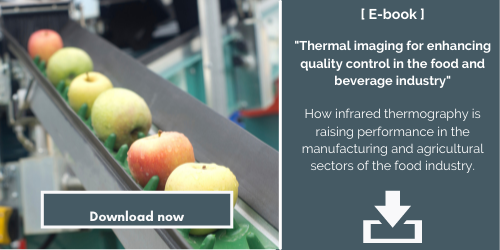Precision Thermal Imaging for Hunting & Leisure: Premium European Solutions for ...
The Hunting & Leisure market is evolving—driven by advanced technology, changing regulations, and the expectations of a new generation of responsible hunters...

June 29, 2021 . 3min read
Over the last few years, SWIR infrared technology has carved a foothold as one of the most effective solutions for improving quality control processes within the food and beverage industry. This sector is renowned for its stringent safety requirements, such as maintaining the cold chain, keeping a close eye on the quality of the containers and packaging used, and detecting foreign bodies in production lines.
Unlike X-ray imaging, SWIR infrared imaging provides food industry professionals with a non-invasive way of monitoring performance and guaranteeing repeatability within their manufacturing processes. These solutions ensure continuous quality control across the production lines.
In this article, we describe the three reasons why SWIR infrared imaging is attracting a growing following in the food and beverage industry for improving quality control.
Today's food and beverage industry is constantly focused on meeting consumers' needs for perfectly graded products boasting flawless quality. That explains why drastic quality control processes are used to continually examine food products and analyze their appearance and condition, especially with the SWIR infrared technology.
SWIR infrared sensors scrutinize organic materials across production lines to detect any deterioration that is invisible to both the naked eye and the traditional vision systems used in the manufacturing industry, such as regular daylight cameras. Since the slightest deterioration can alter the product's qualities, identifying defects is mission-critical for sorting and eliminating damaged food.
Examples include pinpointing and removing damaged fruit from the production line before it ends up on supermarket shelves, as well as identifying high moisture levels that could cause mold spores to grow early and spotting contaminants making food unfit for human consumption.
Hyperspectral sensors are capable of sniffing out moisture in food products and determining their fat and protein content. This ability means that they are spawning across food production lines as industry professionals strive to gain intel on the extent to which fruit has started ripening or to analyze the protein and fat content in meat. The food industry and especially companies using automated food production systems are also installing SWIR infrared imaging solutions to check packaged cheese and assess the degree of moisture that is likely to cause mold to develop early on the cheese.
To learn more about another sector of activity in which thermal imaging makes a strong contribution, download our free white paper on thermal imaging for the food and beverage industry.

The food and beverage industry is leveraging the SWIR infrared imaging technology to ramp up quality control performance throughout the manufacturing process, even for the most complex products, which in turn guarantees superior food safety.
Fitting SWIR infrared sensors to food production lines can reveal unwanted foreign bodies that could potentially be dangerous.
For example, SWIR infrared imaging has the ability to zero in on microscopic pieces of polymer when producing such loose foods as rice and coffee. The technology can also root out stones and metal fragments that could potentially be extremely hazardous to consumers and severely damaging to a food production plant.
The raw materials transiting over a food production line can be inspected with SWIR infrared imaging before they are used and blended with other products. This ensures that they are free of any impurities that could compromise the final product and result in food and beverages that are dangerous and/or unfit for consumption. Raw materials that have been altered by external elements or contaminated by unknown compounds represent a health risk.
One example involves analyzing liquids and solids through their containers with the infrared technology, which is capable of picking out intruders within a material in mere seconds.
Using SWIR infrared imaging technology to inspect raw materials can also supercharge production performance while minimizing production downtime and enhancing product quality.
Note that 30 tons of potatoes can be examined every hour across a production line.
When it comes to food, cleaning products and medicines, SWIR infrared imaging can also see through containers. It is capable of assessing the fill rates in opaque bottles or determining whether blister packs are missing any capsules. Although these applications might not necessarily have a direct effect on improving product or consumer safety, they can boost performance and increase compliance with regulations.
For instance, the technology can spot plastic bottles that have only been half-filled or blister strips that have been damaged or are missing some of their contents (pierced capsules or incomplete tablets), meaning that they are unfit for sale because the product's integrity has been compromised.
To ratchet individual vision systems up to the next level, the SWIR infrared technology is the perfect fit for thermographic inspections, because it can see through glass and therefore keep tabs on high-temperature manufacturing processes above 200°.
For example, SWIR infrared imaging has gained a foothold in the glass bottle manufacturing industry as well as in various metallurgical processes, especially to detect impurities in metals.
SWIR infrared imaging reinforces safety in the food and beverage industry by guaranteeing product integrity through regular leading-edge quality control processes. It can also drive bottom-line performance by reducing losses and ensuring flawless production quality that meets expected standards.
To learn more about another sector of activity in which thermal imaging makes a strong contribution, download our free white paper on thermal imaging for the food and beverage industry.
